A giant snail’s a comin.’ The snail moves slowly but surely over the horizon, across flaxen plains, this near barren landscape overlooked by a rundown villa with a rusted aluminum roof. The one upstairs window of the villa is dark and facing the wrong way, the fence outside in the yard has several pickets missing. The snail is my dawning realisation—Brent Wong is still alive!
Let’s take this slowly. I got the invite to James Blackie Gallery in May. The exhibition featured works from Brent Wong’s personal collection including ten never before seen paintings. Hold up. More? Wong is the outlier painter of hard-edged New Zealand surrealism known for his mysterious concrete constructions floating in palatial blue skies. Take Misconception (1969) for example. A grey shop sits in a landscape with a fissure running through it. This scene reads like a dusty Western, a town abandoned to ruin, except for the large clearly manmade shape floating in the sky as riddlesome as a Rubik’s Cube. I had assumed Wong a hermit, long gone, lost into the vast landscape of time, leaving behind only his confounding paintings, a singular reverie of derelict villas, empty shopfronts, and those concrete constructions floating in the abyss. Now, a giant snail had rode into town.
The day I arrived at James Blackie’s wharf hemmed gallery an older couple were browsing the hang. The man had a New Yorker tote bag. I have one too, but mine was at home. “I’ve always loved Brent Wong,” I said. “What do you think it is about his paintings?” I asked. They turned to me, cordial, patient. “They are about two things at once,” the man said. Or was it her who replied? Either way, they were art-splaining. Wong’s distinctly ‘New Zealand’ landscapes are done with a surrealist twist. They’ve been exposed to the literature I thought. And sure, the giant monarch butterfly fixed to the banal looking state house in Building and Sphere (1974), does remind me of suburban drives in my 1970s kiwi childhood, that claustrophobia, the desire to wrap myself in a chrysalis, turn into an artist and... get out.
I binged on the salon hang. I clocked the influence of Magritte’s Personal Values in the drawers, kettle and teacup in the foreground of Volcanic Landscape with Still-life (1973). But oh, the small swarm of jellyfish! And the snail was back, suspended below a hot air balloon and floating above a smoking volcano! On land the garden snail moves at only 0.048 k/h, but in a hot air balloon who knows? The celestial jellyfish and the snail struck me as important new cast members in Wong’s psychodrama.
Something’s always up in the air with Wong, in every composition he insists on always showing the horizon. In Still life (1971) a smack of jellyfish pleasure-ride across the blue sky, flanked by a pale moon, the plains far below, decorated with a frill of low-lying cloud. One jellyfish is pale pink, delicate, feminine going the other way from the pack. I fancied the snail and jellyfish as flighty forerunners to the concrete constructions. I browsed the hot air balloon in Untitled Scene (1973) and thought: he’s really got a thing about gravity. Over Easter, my family and I stayed in a Marlborough Cottage and woke up one morning to the dragon-y breath of hot air balloons passing overhead.
What do I feel when I look at a classic Wong like Town Boundary? A dinky triangular roof wears a chimney and faces toward an Escher-labyrinth form hovering in the sky. Simultaneously tranquilized and terrified? A bit excited? No matter how long I drink his paintings in, I’ve never reached the end of the looking.
Is he a big Sci-fi reader? I walked along the display of framed giclee prints at the gallery. In The Wandering Land (1973) a husk of hill has come loose and is moving along like a cloud or drone. Trauma (1973) is a series of deep sand dunes that run vertically across the print like rivets. In the background, a scallop shell, matches the grooves of sand. It is intense, but what’s traumatic about the beach? Everything my mind replies.
James Blackie told me Wong lives in Muriwai and has retained many of his own paintings. My mind was agog at the possibility of all those Wongs. Primary Differential (1970) was leaning against one wall, waiting to be hung. In it, a falling down church appears out of the coastline, out of the sea. Blackie turned it around and showed me the back of the board containing the title, and various notes in Wong’s handwriting.
“Does he zoom?” I asked. “I’d like to interview him.”
“He’s very good on email or the phone.”
“Where are you going to publish the piece?” Blackie asked.
“Um...I’ve just started a Substack,” I replied.
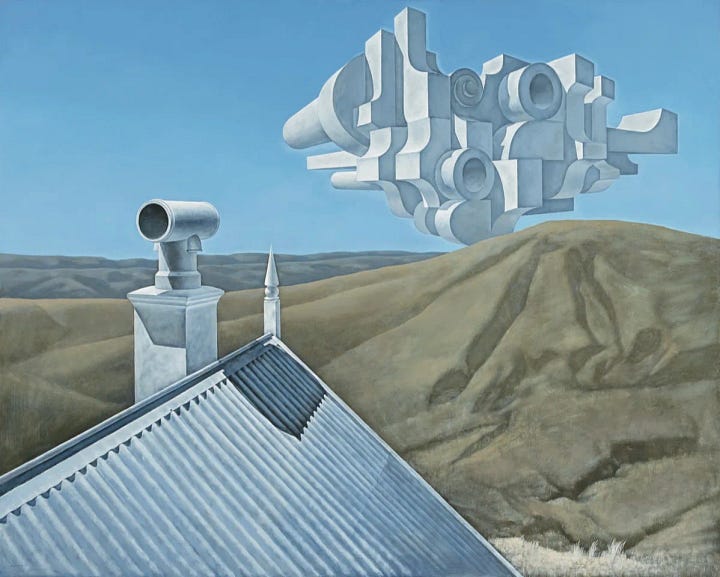
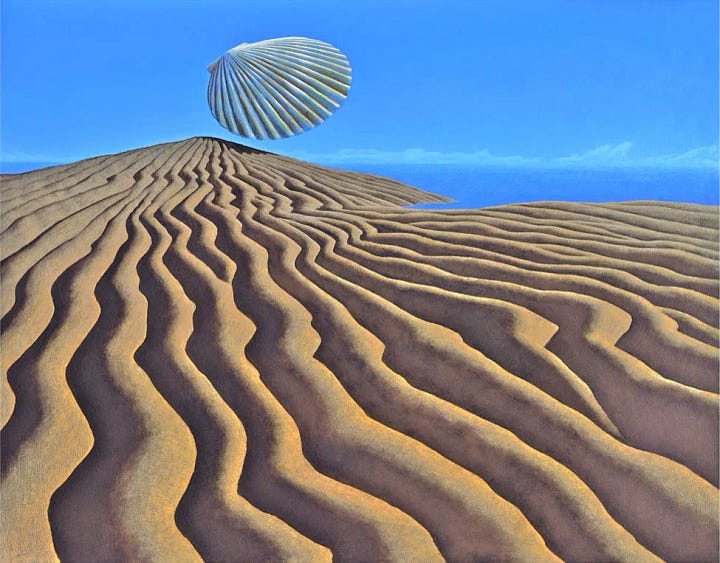
His voice was whispery, gentle, a slight rasp, but clear enough to hear.
“Ideally I wanted to be a composer,” he said. “A romantic idea one has a teenager. It’s lots easier to make pictures, not that it is easy to make good pictures.”
He’s right, it is not easy to make good pictures.
“There’s a print of yours in my therapist’s office.” I had sent him a photo of Green Hill – Pink Cloud (1976) in situ, before our call. I usually sit in the chair opposite the print in the waiting room jiggling my crossed leg and riffling through the old Women’s Weekly magazines.
“A lot of people like that print,” Wong said. “The print is not in good condition.”
No, Green Hill – Pink Cloud is in terrible condition, placed above a radiator, adjacent to a small print of a McCahon cross. Only the heavy weights go to therapy.
“That was very composed piece, arranged to look casual. When it was first printed the star was missing.”
I hadn’t noticed a star on the print in the therapy waiting room.
When the printer was preparing the film to produce the Cromalin print, Wong said, “You haven't cut out the star, have you?” The printer had! But Wong caught it in time.
The star was the point of the picture—and even though it was right in front of me —I had been missing it, for years.
Wong tells me he is fussy about composition, technical, if it is off centre, it is more interesting.
He didn’t paint one aspect of the composition at a time. He built up his paintings layer by layer in acrylics, and suggested this approach helped the final composition achieve a sense of integration.
Before I called, I had poured over his personal website for hours looking at the many configurations of the concrete constructions, each suggesting that reality had another layer to its matrix, just a click of the Rubik’s cube away. These compositions were overtaken by cloud studies and landscapes—horizons, permeated by light and shade, Clouds Obscuring the Sun (1987), and the sublime View of the Road (1976), disappearing into the blue horizon like a plank. I then clicked the tab onto his Light and Energy works. The titles said it all: Breathing (1987), Consciousness (1988), Transmutation of Energy (1988). I had a guru of painting on the end of the line, and I was nervous, scrawling his replies to me in biro sideways down the side of my notebook, quietly freaking out.
Wong was born in Otaki in 1945 and grew up in Wellington. His father was Chinese but had been adopted as a child by an American judge and raised in California. Wong’s mother was a pakeha. His parents had met in Whanganui and moved around before settling in Wellington. Wong described his father as ‘an entrepreneur’, he ran an importing and exporting business for Chinese products – dried fish, pyramids of rice, taros, soy sauce. His father owned three shops on Vivian Street—143, 145 and 147. These are the shopfronts that often appeared in Wong’s paintings, like Misconception. Wong and his parents and siblings lived above 143 on the corner of Dunlop Terrace. 145 was the family shop, and out the back was a meeting place for the men from the local Chinese community. Wong recalls the raucous sound of them playing mahjong. In the tiny backyard, hung shark fins and deers tails. “It was like a little bit of China Town in Wellington.” The notorious Purple Onion Revue was at number 140 Vivian Street.
Growing up Wong felt alienated at school and often wondered, “Am I Chinese or a New Zealander?” He was dyslexic, and couldn’t easily read or write music, another obstacle for becoming a composer. “I was very interested in music you see.” He explained, “You need to be part of the music fraternity to get your compositions played.” When he was five years old, the family moved to Hong Kong for his father's work. Wong remembers the bamboo scaffolding, and beggars on the streets, it was a terrible culture shock. “Traumatic,” Wong says. Eventually his mother and all the siblings returned. His father stayed. He only saw his father a couple more times before he died.
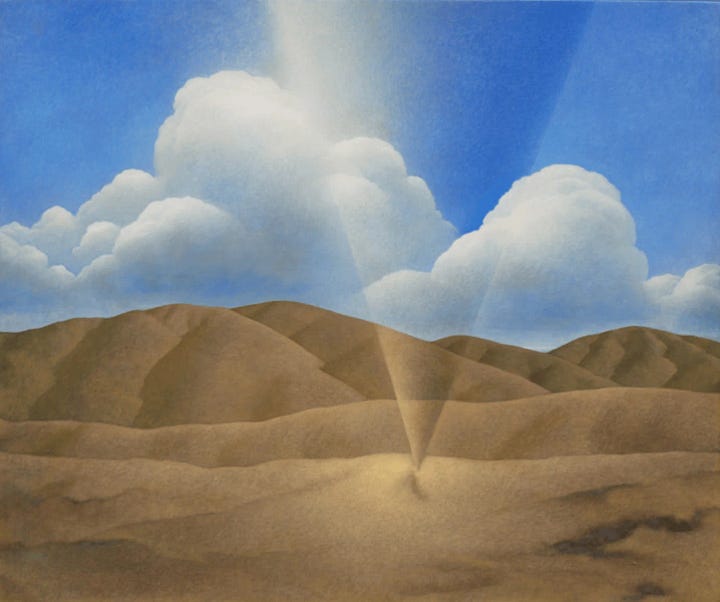
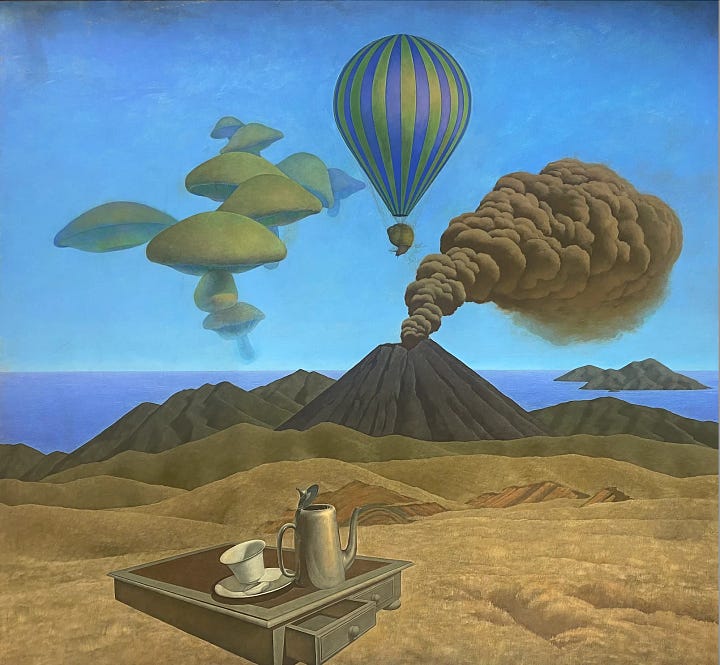
In 1969, the twenty-four-year-old Wong exhibited twelve paintings at Rothmans Gallery in Wellington and burst into the New Zealand scene, seemingly fully formed. Wong told me his subsequent show at Barry Lett Galleries and the award of a QEII grant changed his life.
The seventies are where the serious literature on Wong begins—but also pretty much where it ends. I hunted down the catalogue produced for Wong’s solo show at The Dowse Art Gallery in 1977. The catalogue gives an excellent precis of Wong’s technique, and his formative years, including his brief stint at Wellington Polytechnic and his role as a copy holder for the Dominion Post. This job gave him the time and newsprint to doodle on, many of the drawings informed his later construction compositions.
Jim Barr interviewed Wong for the catalogue too—
Do you think of yourself as a Surrealist?
No, not really.
I mean in any conscious way?
No.
I don’t think of Wong as a surrealist either. The articles I’ve read —including a very good Neil Rowe piece in Art New Zealand—hint at an extended illness that enabled him to concentrate on painting. I wanted to know more about his illness...what was it?
Wong told me during this era, he was on antidepressants, drinking black coffee and smoking cigarettes, crouched down at the easel, painting for hours. He worked very solidly, eight hours a day, every day, except Christmas. But he wasn’t eating well, didn’t know to focus on his own nutrition and was not sleeping properly, was worried about money. He got terrible headaches and was put on medication but didn't want to talk to a psychiatrist. His sister let him paint in the spare room at her place on Ghuznee Street. It was there that he began producing a jaw dropping body of work.
Wong tried to get his paintings to match his intentions, to be unemotional about the process. “I try to get it to the point where I look at it one day, then when I look back at it another day, it still looks good...You do it by staying with it,” he said. “You build the painting up like chipping away at a stone until the bear emerges...I paint them until I feel they are right.”
“I’m on antidepressants,” I said. “For my anxiety.” I’ve been on them for years. I sensed somehow that was why I was calling, because I suffer too from terrible anxiety. Was that the hook? The recent viral Doechii song Anxiety was on my mind: “somebody’s watchin me, it’s my anxiety...”
I felt his works had been secretly keeping me company in my own state of unease. In the therapy waiting room Green Hill – Pink Clouds omits a strange stillness and calm. McCahon’s cross does not.
In the eighties, Wong bought a church organ from America and had it shipped over. He used to play Bach on the organ and attend concerts at Saint Matthews on Symonds Street, that had “a beautiful atmosphere.”
I scrawled down his recommends: Górecki’s Symphony of Sorrowful Songs, and Arvo Part, “the incredible Estonian composer. I’ve never heard anything that compares with Arvo Part, I was knocked out by it, the music is so immediate.” Then he said, “At one end of the scale is Bach, at the other end the Rolling Stones.”
I knew which end of the scale he preferred. Wong’s painting compositions are classical, filled with arched spaces and resounding silence.
“Your brother Wong Sing Tai is also a painter. Was one of your parents artistic? Where does you painting come from?” I asked.
“I don’t think of it as coming from anywhere...” But then he reflected on his mother. “Later in life she did some very good watercolours of sunsets, flowers, landscapes.”
Wong has a technician’s precision and focus. I sensed his praise was not dolled out lightly.
Our conversation turned to meditation. "I see a spirituality in your work, a transcendental quality,” I said. “Do you meditate?”
Yes. “Meditation is about trying to achieve silence in the mind, trying to be in the present,” he said.
Knew it, I thought. Though given that one classic Wong painting is actually titled Meditation, the connection was hiding in plain sight—waiting for me to finally notice it, like the star in the sky.
Wong's high point for meditating came in the 80s and 90s. “It takes an enormous amount of concentration” but after several hours he achieved an elevated state of consciousness.” The experience was “transformative. It’s like taking a little circuit away and putting in a new one.”
“I’ve always wanted to meditate but I’ve never been able to do it,” I said. The idea of no thoughts has always appealed to me, but I have failed the apps.
“My father used to meditate,” I said.
“To get into the state of being not thinking is very, very rare,” Wong said.
“But I’m just an ordinary bloke,” he said, “I’m no more spiritual than the next person.”
His dealer Blackie said Wong was a very lovely and humble man. True. But I didn’t quite believe he was no more spiritual than the next person.
“I think everything has consciousness,” Wong said.
In the eighties and nineties, his realistic surrealist landscapes were surpassed by abstract shapes, spheres, cones of light. He considered these works his most significant. “In the late eighties when I looked at simple things like a saucepan in the sink, I focused on the light on the saucepan...”
I had finally completed one side of the Rubik’s cube, and understood why Wong’s paintings are so gripping. The concrete constructions floating in the sky are like new circuits being put in. In his paintings I feel this persistent anxiety, even though there’s never a person in sight. And across his work I see a continuity in consciousness. Each Wong composition is a clear, quiet altitude where the mind can finally reckon with itself.
“What is it about blue?” I asked.
“A restricted palette colour has more impact,” Wong said.
Unity (1993) is a beautiful painting of concentric circles, one held within the other. The core is blue.
“There’s something about blue, you can look endlessly at it, it has a depth and a spirituality, the infinite...” Wong said. He told me a Christian neighbor had seen his painting Peace and burst into tears. “Ordinary people can come into the house and look at the paintings and react.” These are the kinds of stories I love. Worlds away from art-splaining. Worlds away from peace.
In 2008 he stopped painting because it wasn’t working any more. “It was time to stop.” He intended to put his paintings into a charitable trust.
“Where’s the church organ now?” I asked. “It’s currently broken, my attempts at Bach somewhat dwindled.” He had however later in life managed to write a piece of music and hear it played as he had imagined it. Wong told me he doesn’t call himself a painter anymore, a Sunday painter at best. I had called on a Sunday too.
“I’m in the Brent Wong Fanclub,” I said. “And I don’t think I’m alone.” I had been wandering around with that title in my head for weeks, feeling the rightness of it, but also wondering if it had enough hook for Substack? And if it would please Wong? Could I ever do justice to his work?
“I didn’t think you were still alive,” I confessed.
He laughed. We both laughed. “I’m still here, I’ll be eighty this year. I don't know what that means.”
“I’m as delighted as the jellyfish flying through your sky,” I said.
“That was fun to paint.” The jellyfish photos came from a Science Magazine.
“What about the snail?””
"It was just a common garden snail, psychologists would have a field day,” Wong said.
Since our initial phone call, I’ve been curating numerous Brent Wong exhibitions in my head, with music and without. And I’ve also been procrastinating on writing this piece, fretting it won’t be good enough. When I write about artists I truly admire, I give my words as a gift, like a snail trail. One day I ran into Jim Barr outside Moore Wilson’s. Jim said, “When Wong first showed his paintings in Wellington it was like they’d come out of nowhere.” Looking at Wong’s paintings decades on, I get that same feeling of incredulity, and wonder.
I finally sent Wong my first draft. The snail was speeding up. I called him so we could fact correct. He liked my humour. “I don’t want to be old and mingy,” he said. “Even though I am mingy.” I discovered his whispery voice is because his throat is constricted. I felt bad.
“I need to go over things slowly and think about them,” Wong said.
“I’m impulsive,” I said. “And emotional.”
“Yes,” he replied, good naturedly, “I can tell.”
Maybe that’s why I’ve been relating so hard to the snail moving over the hills in Snowstorm?
“It won’t hurt me to wait for a bit before publishing,” I said.
In one email to me Wong wrote, “Thinking about your last question about my early work...At the time, I was only partly aware of the symbolic elements in the work, although subsequently I’ve realised that the houses, for instance, represented myself and the partly demolished building my old self.”
Yes, I recognise in his work in his work too. My old self is partly demolished and a new circuit is forming.
Slowly.
Thanks to James Blackie and of course to Brent Wong, for their time and assistance and access to these images.




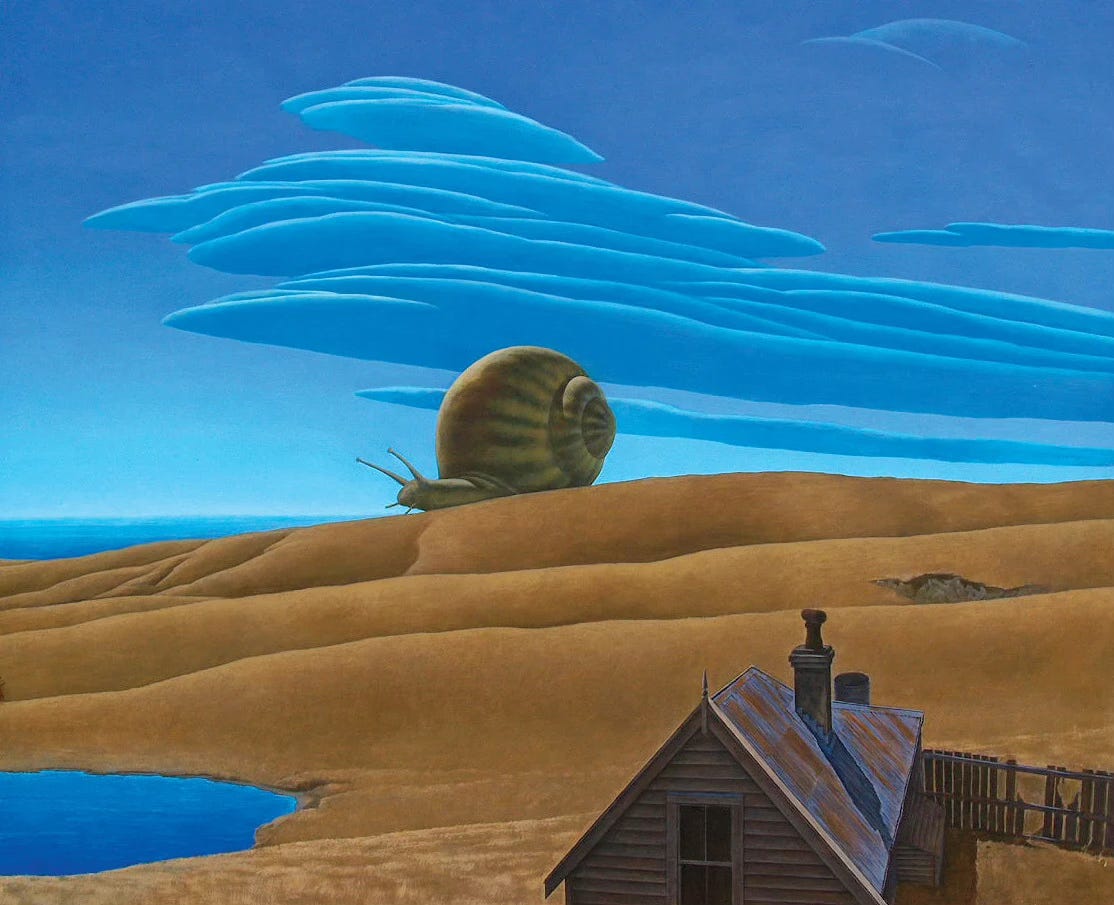
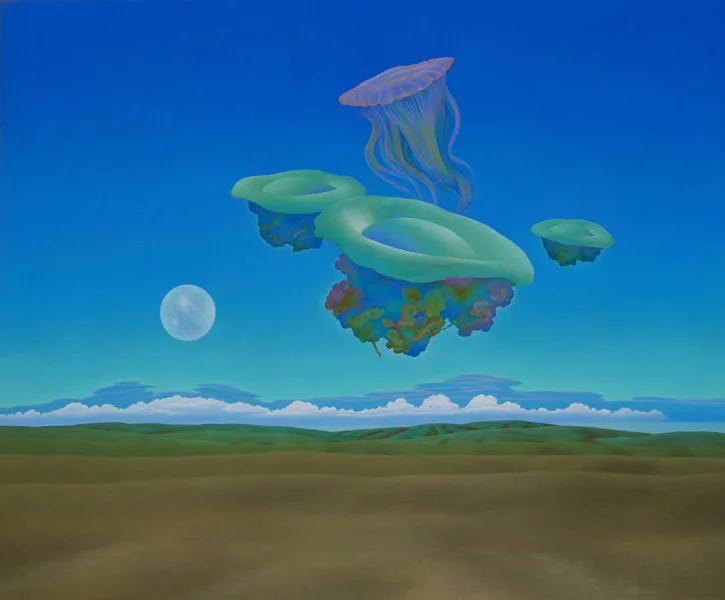
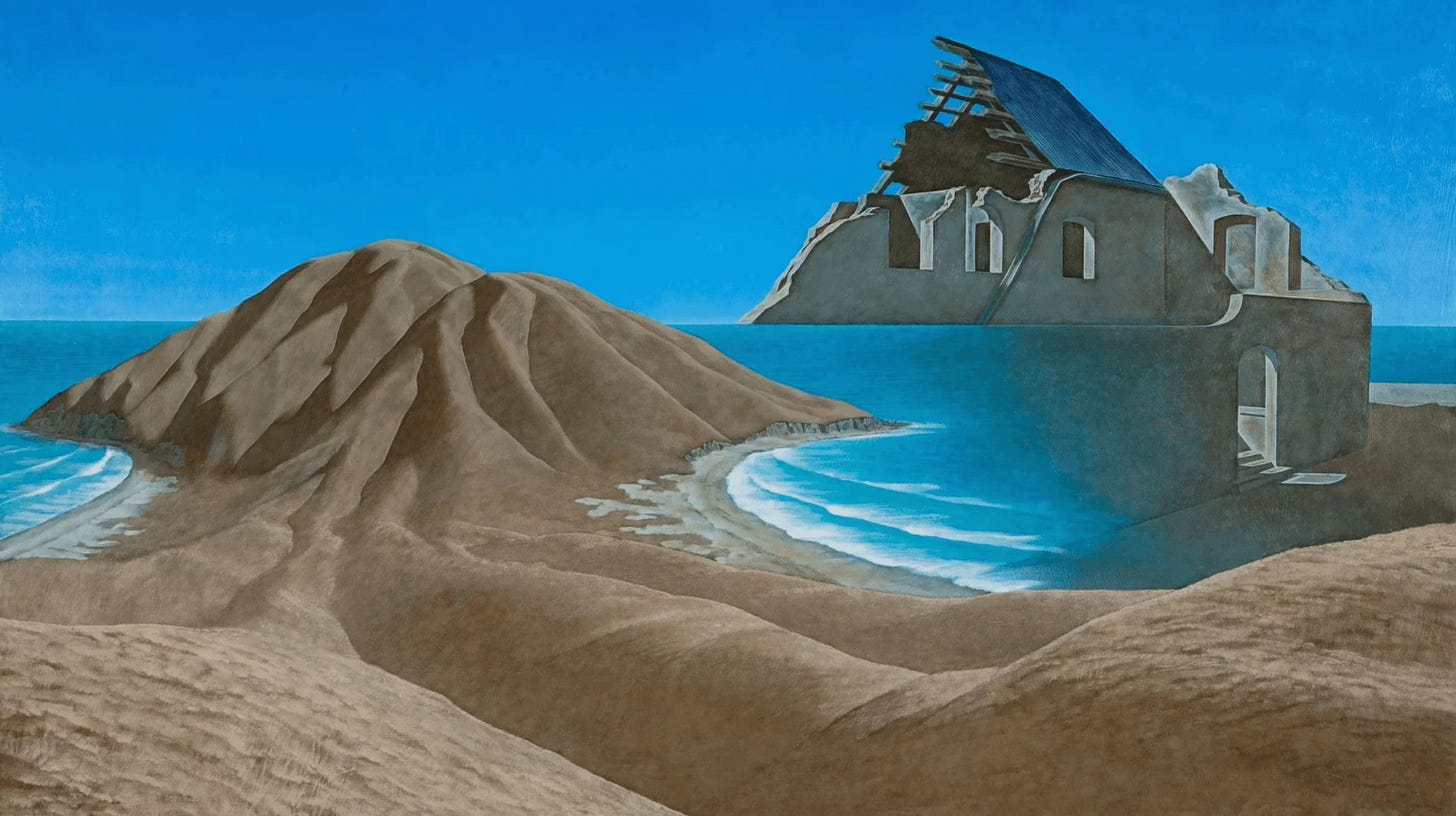
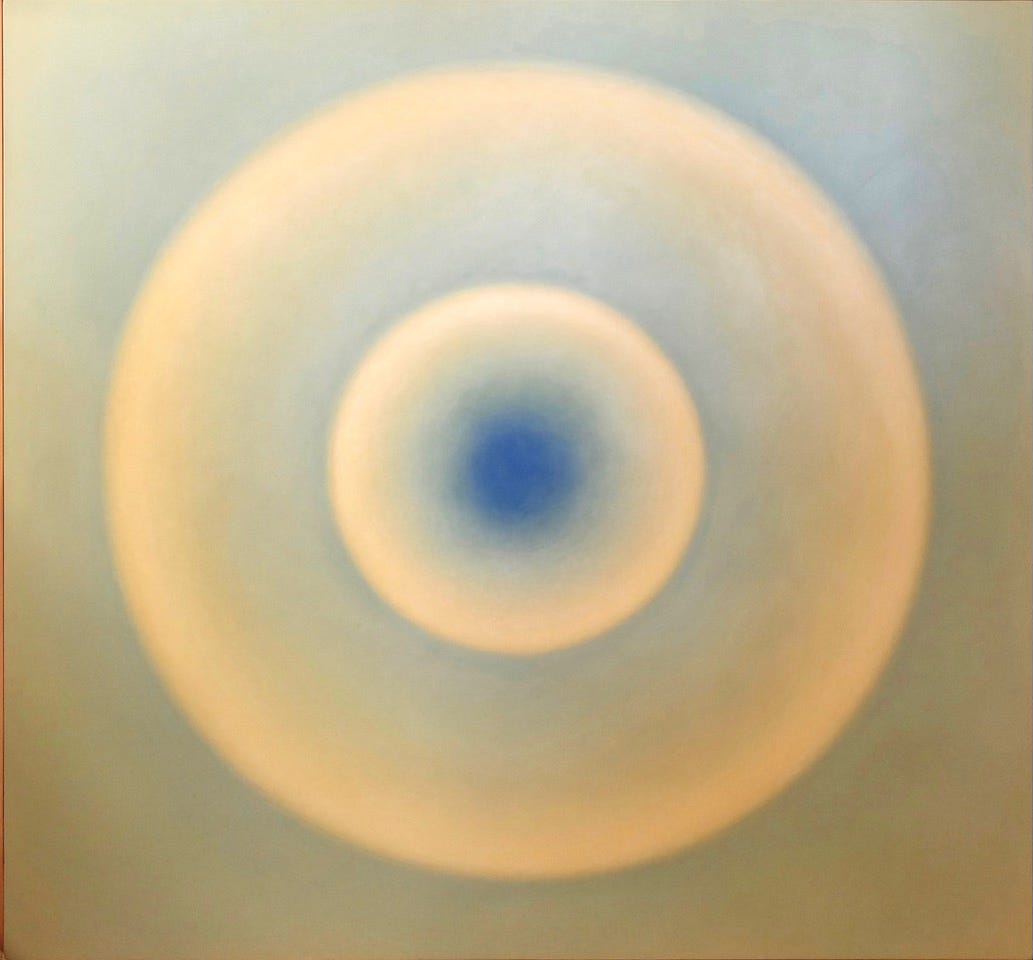
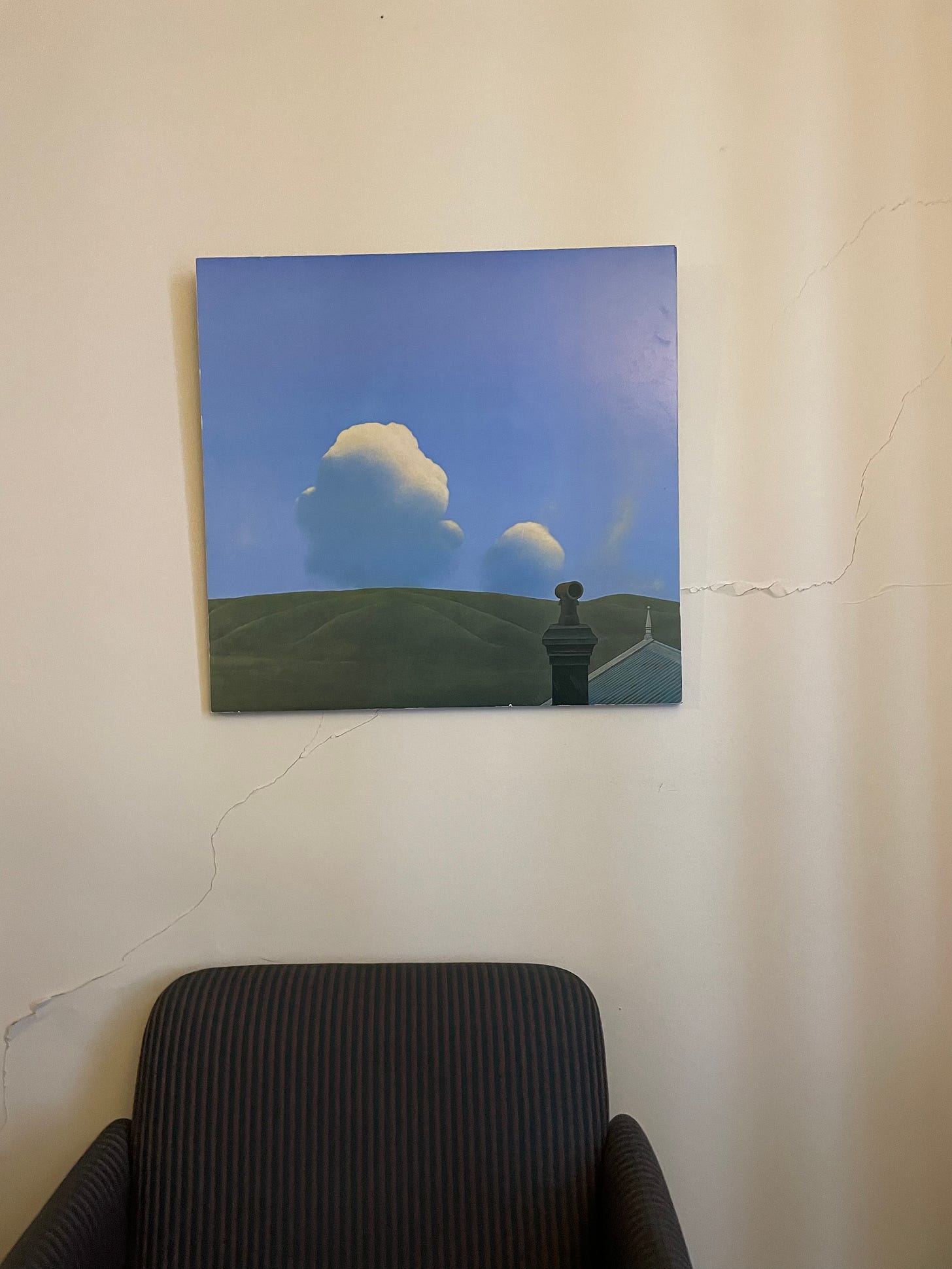
Great writing Megan. I have fond memories of the jellyfish painting as I worked for Harry (Wong Sing Tai) when I was fresh out of design school and Harry was making his science fiction movies. Harry had to return the painting to Brent because insurance was prohibitive. Anyways Harry is another world and much more overlooked as an artist which, considering his lifelong dedication to art, is a real shame. Sign me up to the fan club. P.
Huzzah! The man’s a genius. Looking at his work I was struck by both a sense of apprehensiveness- that snail (perhaps he reads Highsmith?) and ambitiousness - that snail. Anyway thanks for your gift of introduction. I’m hooked, please sign me up to the Brent Wong Fan Club ASAP.